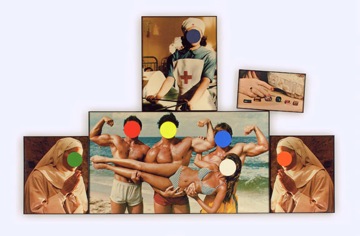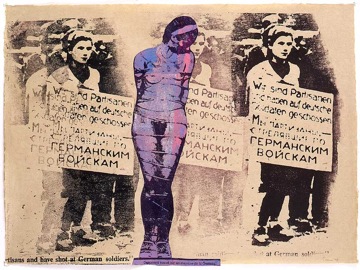
John Baldessari, "Beach Scene/Nuns/Nurse (with Choices)", 1991 courtesy Marian Goodman Gallery, New York
Within the first few pages of the season 5 Educators’ Guide, readers are asked to think about the power and influence of juxtaposing images in order to give the viewer very different experiences. Working with artists like John Baldessari, a few of my classes recently began a unit to explore how juxtaposition has the power to send visual messages, tell stories, and even share qualities about ourselves.
Over the course of a few days, I asked students to bring in and collect a variety of images they would like to combine in a single artwork. After assembling the images and cropping them a bit, I asked them about the images they selected and what these images said about their interests, their habits and even their passions. One student remarked that the images he selected basically described his obsession with money. Another described her images as being primarily connected to food, which is something finds comfort in. Still another described his images revolving around his work related to environmental projects.
As students assemble their works this week, we will also begin moving into some small-group research exploring how juxtaposition can be used to send messages simply by placing certain images side-by side.

Nancy Spero "Masha Bruskina / Gestapo Victim" 1994, courtesy the artist and Galerie Lelong, New York
Students will be asked to work with partners to research and collect images (fine art reproductions, advertisements, posters, etc.) that send specific messages through juxtaposition. Along with viewing works by John Baldessari, we will be also be looking into artists such as Yinka Shonibare MBE, Nancy Spero, Kerry James Marshall, and Eleanor Antin.
Creating high quality works of art that are technically proficient is always very satisfying for both teachers and students, but when we have the opportunity to make students more aware of the images they see, and how they relate to larger themes and broader issues, we are teaching students not only how to create works of art but also how to interpret them.




Pingback: John Baldessari and Juxtaposition « Digital Photography Blog
Pingback: What’s Cookin at the Art21 Blog: A Weekly Index | Art21 Blog